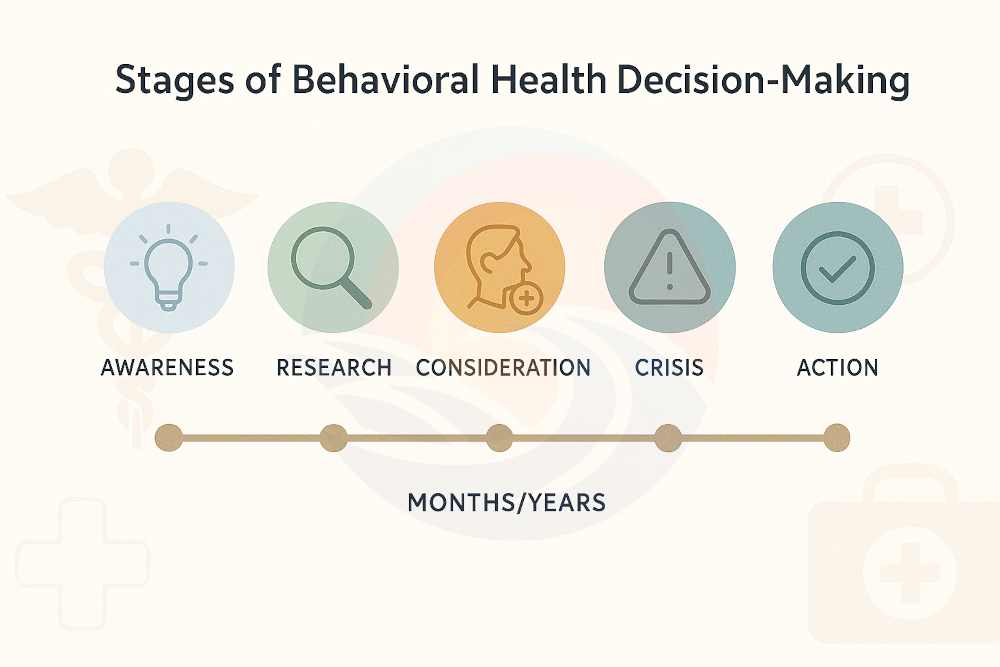When thinking about how behavioral health providers approach patient acquisition. Most marketing efforts focus heavily and primarily on prospects in immediate crisis, creating intense competition for what may be a relatively small segment of the total addressable market.
Observations after working in the space for several years suggest a validation of Chet Holmes’ Buyer’s Pyramid concept and point toward what might be a significant opportunity for strategic repositioning in how providers approach patient acquisition.
The Search Data Tells a Clear Story
The pyramid structure becomes evident when examining organic search performance through third-party SEO analytics platforms. Analysis of a major behavioral health provider’s keyword rankings reveals:
- 80.2% of ranking keywords are informational
- 14% are commercial intent
- 2.5% are navigational
- Only 3.3% are transactional
What’s fascinating is that this distribution emerged naturally. Without explicitly planning for pyramid-based content strategy, search algorithms organically ranked the provider’s content according to actual market demand patterns. Google’s ranking distribution essentially validates the Buyer’s Pyramid by surfacing content that matches where most people actually exist in their decision journey.
This search behavior aligns remarkably well with Holmes’ theoretical framework, suggesting that the pyramid concept accurately reflects how people actually research behavioral health services, even when providers haven’t intentionally structured their content this way.
Crisis-Focused Marketing
The behavioral health industry’s marketing approach appears to reflect a misallocation of resources. Most providers focus exclusively on that critical 3% in immediate crisis, like everyone crowding the emergency room while nobody staffs the regular clinic.
This creates several strategic disadvantages:
Intense competition for limited prospects: Fighting over the same small segment drives up acquisition costs and reduces conversion efficiency.
Unpredictable revenue streams: Relying entirely on crisis-moment capture means missing people during their longer consideration periods.
Missed relationship-building opportunities: The 37% in the middle of the pyramid (7% open to treatment + 30% not actively considering it) represents substantial untapped potential.
Unlike other healthcare services, behavioral health decisions often involve months or years of consideration, with multiple false starts and changing readiness levels. When providers only optimize for immediate-action prospects, they abandon the opportunity to build trust during these extended decision cycles.
The Call Center Effect
The pyramid principle applies beyond digital marketing channels. Call center operations experience their own intent distribution, though the entire spectrum shifts higher than website visitor behavior:
- 3-7% of callers are “ready now”(researched and prepared to start treatment immediately)
- 10-15% are gathering final information before committing
- 30-40% are exploring options but uncertain about timing
- Remainder are primarily information gathering
The key insight is that phone contact represents movement up the pyramid from website browsing, but the same strategic principle applies. Applying identical high-pressure approaches to all callers misses opportunities to nurture relationships with the larger segment who will need services eventually.
Implications for Behavioral Health Marketing
How providers should approach patient acquisition:
Expand Beyond Crisis Marketing
Rather than competing exclusively for people in immediate crisis, develop content and touch-points that serve prospects throughout their consideration journey. This creates multiple opportunities to establish trust before the critical decision moment.
Leverage Existing Organic Performance
The search ranking data shows providers are already being found by people at all pyramid levels. The question becomes whether conversion strategies match this reality or remain focused solely on high-intent segments.
Build Sustainable Pipeline Development
By nurturing relationships across the entire pyramid, providers might create more predictable lead generation that feeds high-intent channels over time rather than depending entirely on crisis-moment capture.

The Long-Term Opportunity
Behavioral health treatment decisions rarely happen overnight. People move through different stages of readiness, often over extended periods. Providers who build strong presence at each stage(from early awareness through final decision) position themselves as the trusted option when prospects finally reach their “ready now” moment.
This approach doesn’t diminish focus on immediate conversions. Instead, it creates sustainable pipeline development that continues feeding high-intent channels by establishing relationships long before crisis points.
The Buyer’s Pyramid provides a data-backed framework for understanding why brand investments beyond direct response matter in behavioral health. It’s not just marketing preference but a business necessity in an industry where timing and trust significantly influence treatment decisions.
As the industry evolves, providers who recognize and optimize for the full spectrum of patient readiness will likely capture disproportionate market share while competitors continue fighting over increasingly expensive crisis-moment prospects.
WillDoSEO.com
